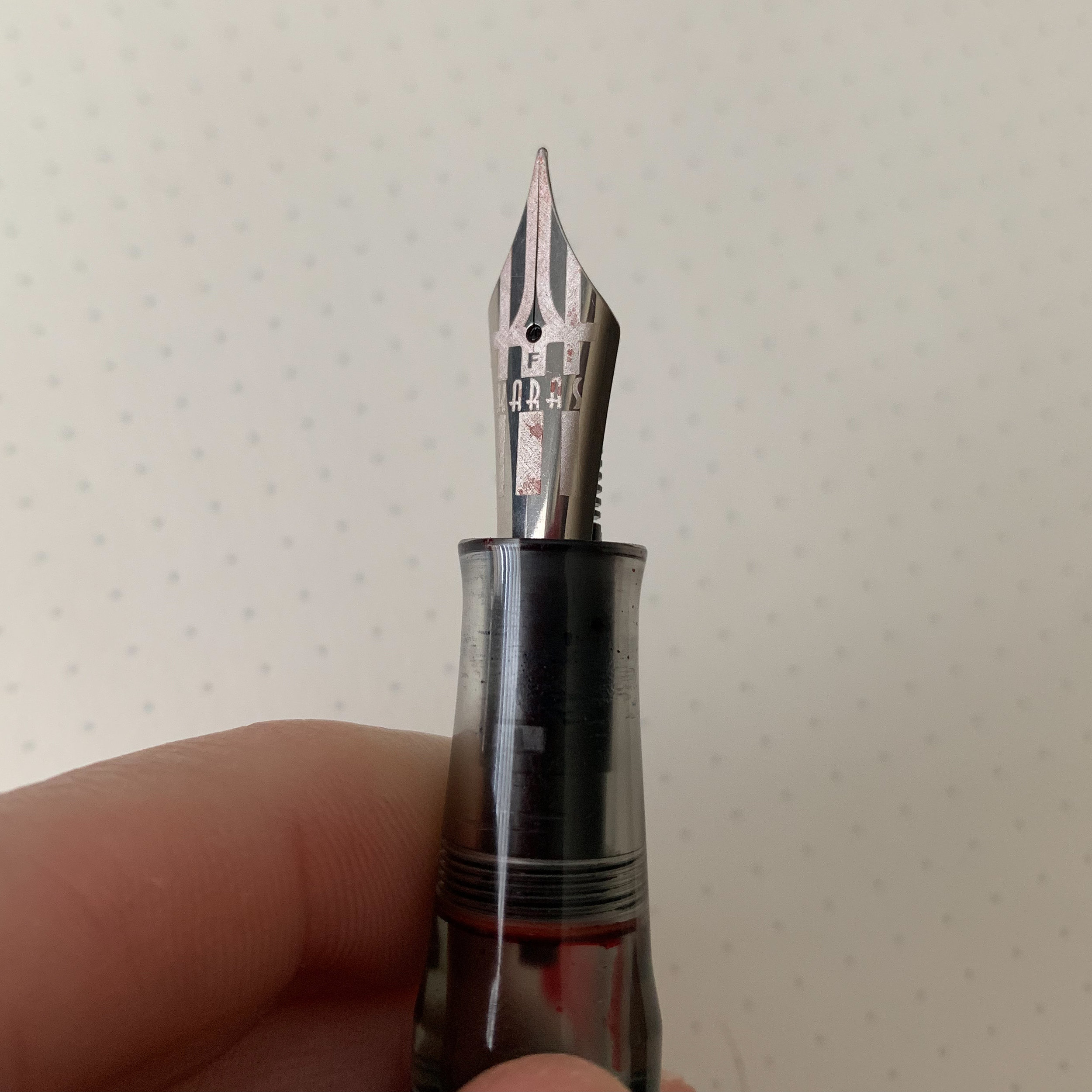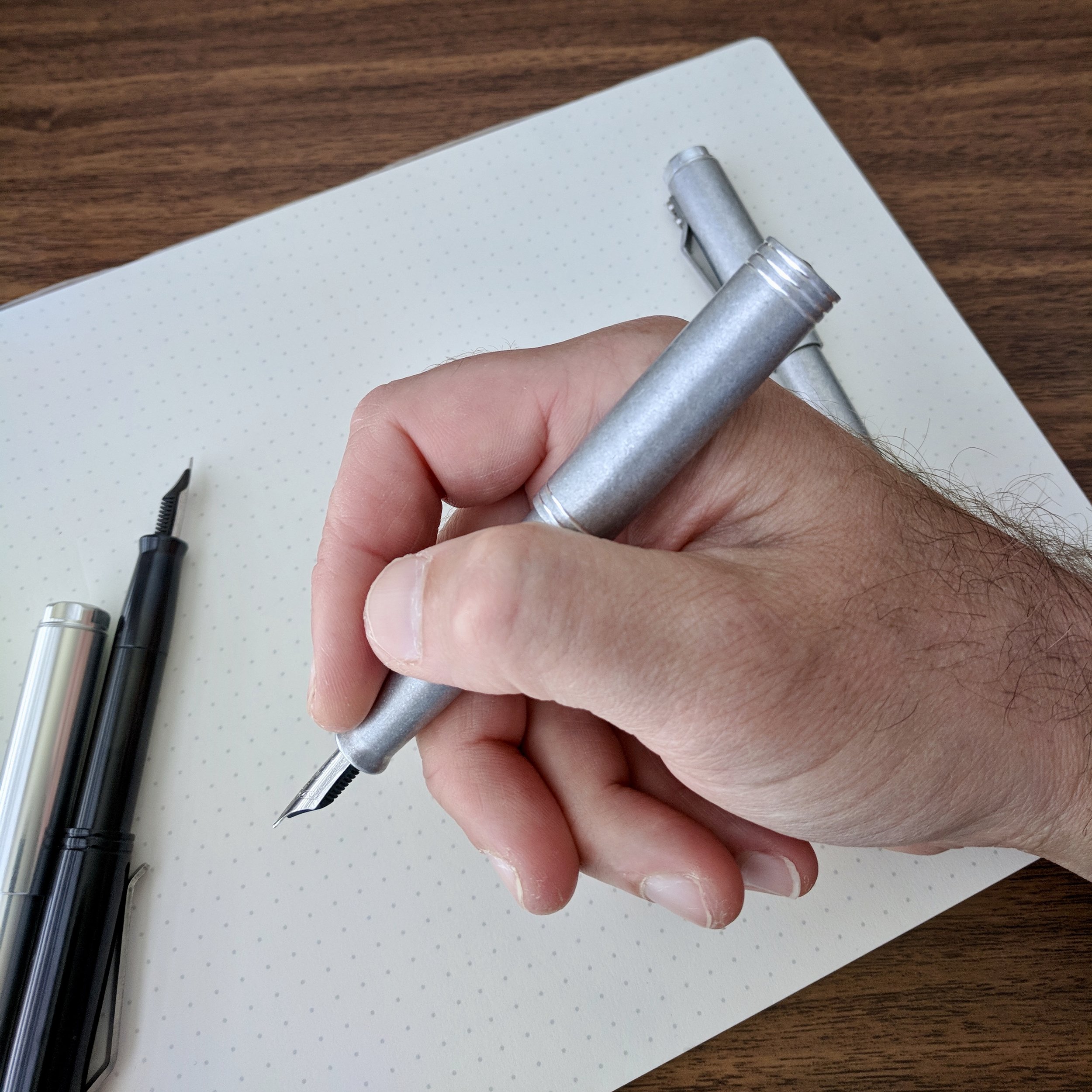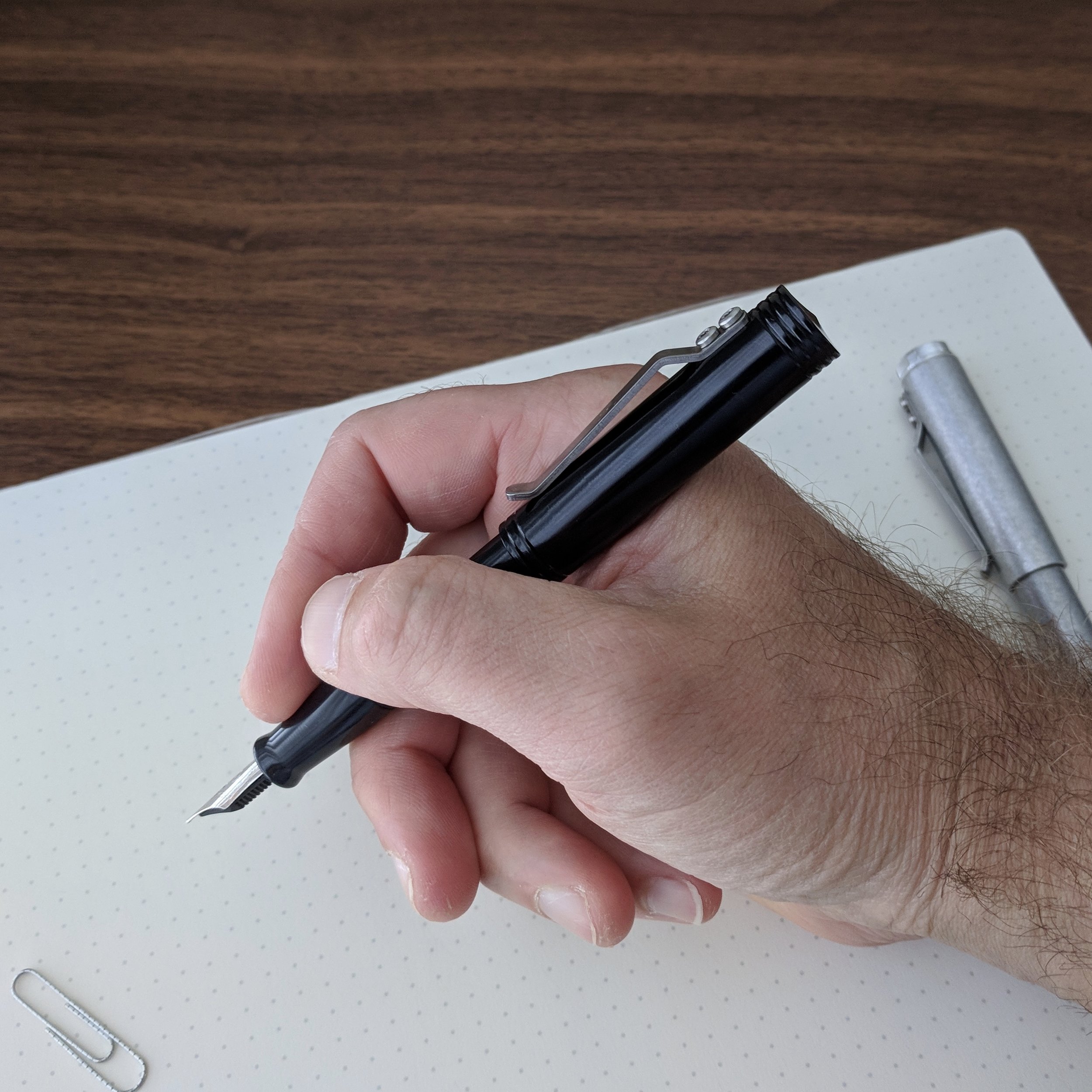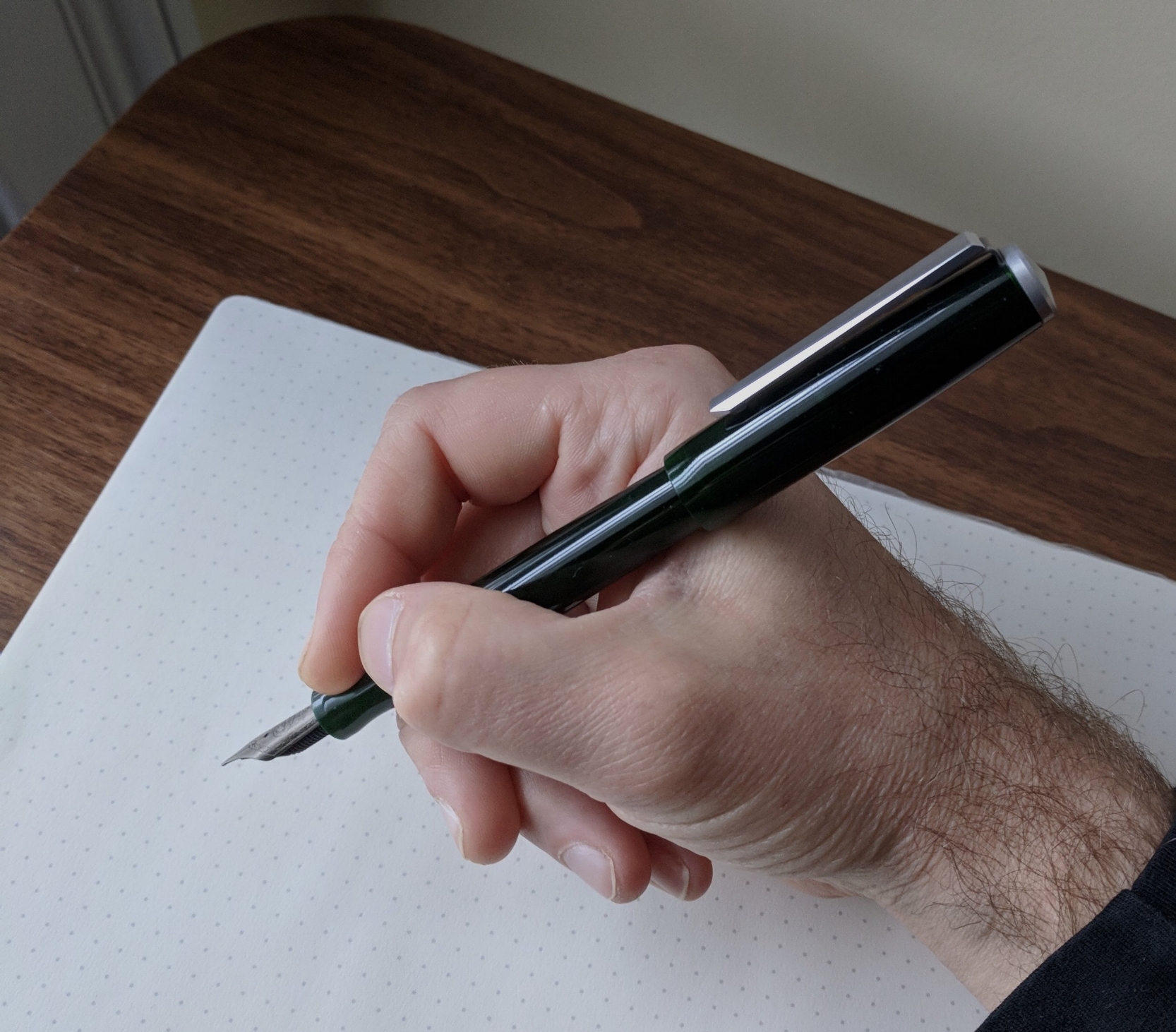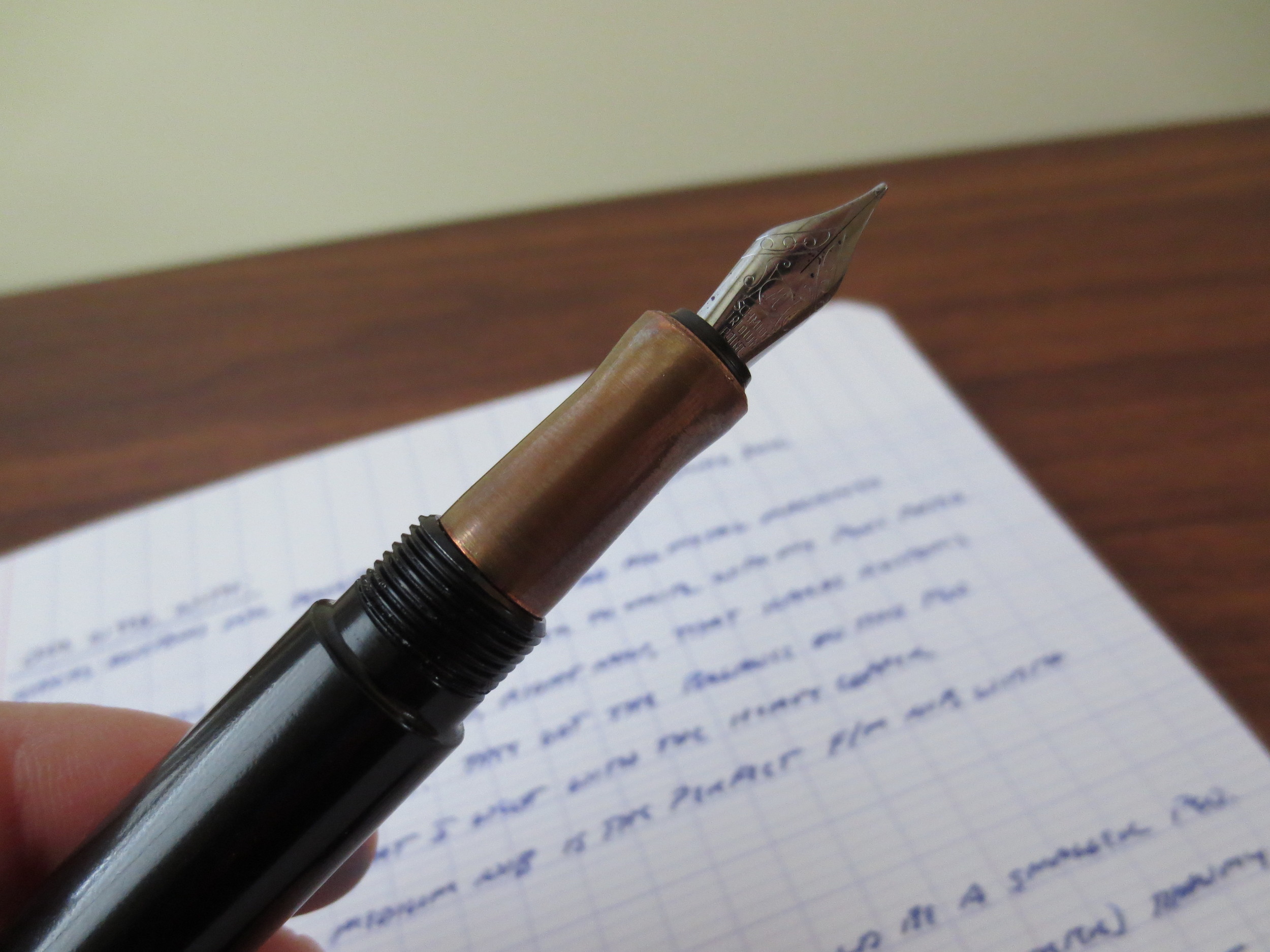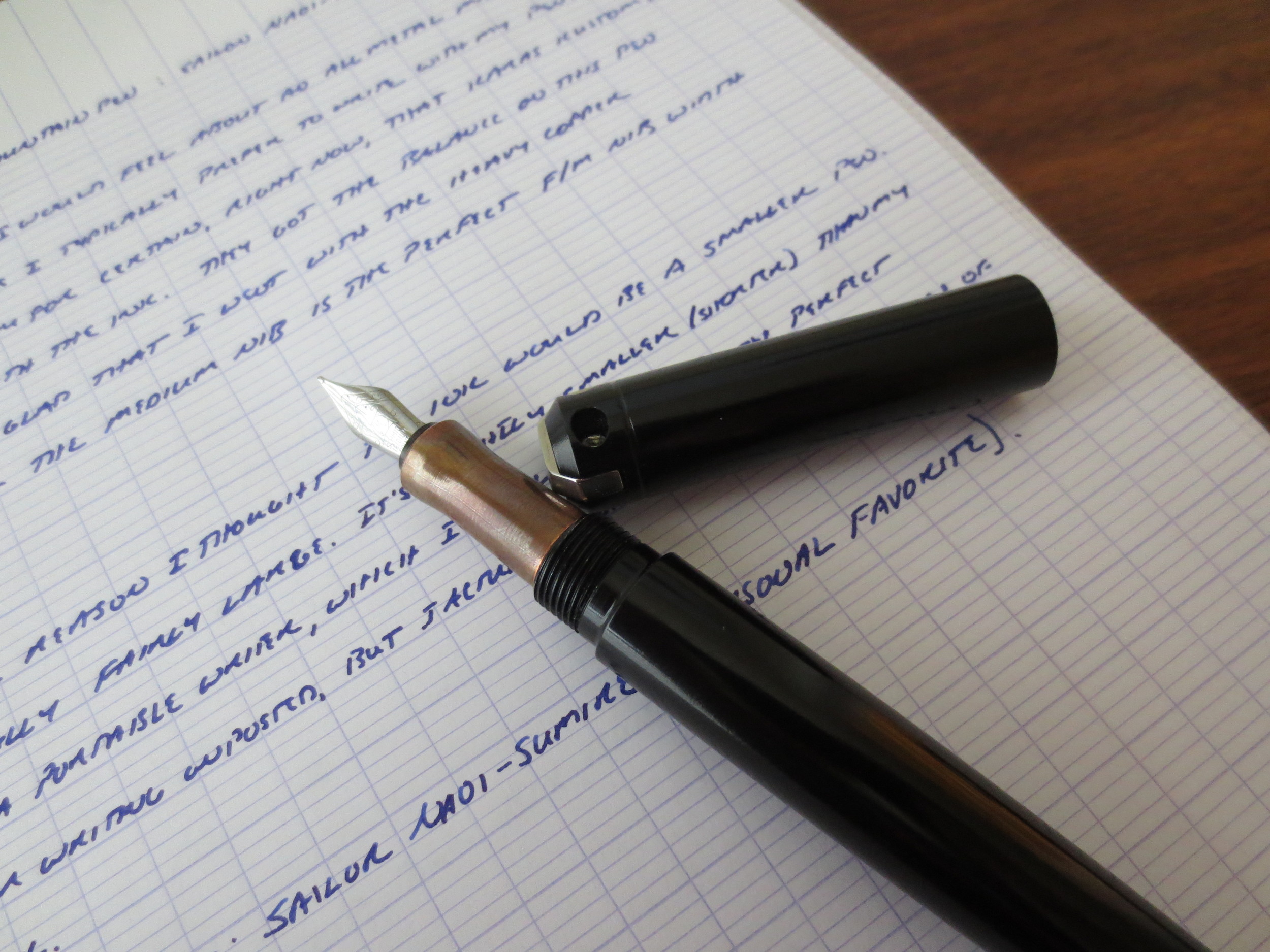While I wasn’t one of the lucky ones able to snag an original Vertex prototype when Karas teased the pens late last year, I admired them from afar and have been waiting for their wider release. Earlier this summer Paul from Karas Kustoms contacted me and asked whether I would be interested in reviewing the finished product. I received for review a Vertex in limited run “Galeocerdo” acrylic, which I would describe as a multi-toned metallic silver material that I hope makes its way into regular production at some point. As for the pen itself, overall I’m impressed with what Karas has done, but the Vertex still has some issues that give me reservations about issuing an unqualified recommendation. Read on to learn more.
As always, Karas Kustoms gets creative on their packaging. My Vertex shipped in this machined aluminum box, with a foam insert to protect the pen.
Vintage-Inspired Design and Maximum Writing Comfort
Let’s start with what I really enjoy about the Vertex: the look of this pen and how comfortable it is to use for long periods of time. Karas has carried over the vintage design aesthetic from its previous “Signature” release, the Decograph, into a shorter, chunkier pen that I prefer. (While I enjoyed testing the Decograph, over time I found the pen slightly too long posted.) The long, concave section on the Vertex is outstanding, and in addition to comfort you can modify the look of your pen by swapping in a section made from a different color acrylic. Karas sells replacement sections separately, so you can purchase more than one.
The metallic shimmer on the Galeocerdo acrylic makes me want to see more of this material. Hopefully the initial run was not a one-off.
As an acrylic pen that uses a cartridge-converter/eyedropper filling system (more on that below), the Vertex weighs next to nothing. For me, the pen has the best balance when posted, and I happily used this pen for three full days of work drafting and annotating documents longhand. The cap posts securely, and the lack of threads on the long section makes the Vertex a great choice for those who, like me, tend to adjust their grip higher or lower as I write, and don’t always hold the pen the same way. While the section is smooth, it has enough texture to provide a good grip, and I had no issues with slippage even after long writing sessions.
Here, you can see (1) the transparent acrylic section, which is slightly concave; (2) the ink window; and (3) the o-ring embedded in the section to prevent leaking through the front of the pen.
One interesting design choice that I ended up enjoying was the decision to make the top of the cap concave.
Optimized for Eyedroppering
Karas designed the Vertex as an “eyedropper” fountain pen, meaning that the pen’s barrel can be used as an ink reservoir without resorting to a cartridge or converter. That’s both a blessing and a curse. On the plus side, used as an eyedropper, the Vertex holds a massive amount of ink so you can avoid refilling frequently. Aesthetically, filling the barrel with ink also allows the transparent section to function as an ink window, a conscious design choice and my clear preference since a visible cartridge or converter would, in my opinion, destroy the beauty of the pen. The Vertex incorporates custom fit o-rings into the barrel and section so that the pen ships “eyedropper-ready,” with no need to add silicone grease to seal the threads. The cap also features an o-ring, which creates a seal that not only keeps the cap closed or posted securely, but should prevent ink from leaking out in the event there is a spill in the cap. Which brings me to….
The downside of this design. The main flaw in the Vertex is that the o-ring on the interior of the cap can create pressure that draws ink out of the nib and feed when you uncap the pen. To avoid any issues, Karas recommends that you uncap the pen with the nib pointed up. I would add that you should try to uncap the pen as slowly as possible, and to avoid using the cap as a fidget toy, which I confess to sometimes doing with my slip-cap pens. But even exercising as much care as I possibly could, I still ended up with ink on the section, in the cap, and on my hands on multiple occasions, with the problem getting worse after I had transported the pen in my bag to and from the office, where changes in air temperature likely increased the tendency to burp ink. I will note this temperature issue is a problem inherent in most eyedropper fountain pens, unless they incorporate a valve or seal like those found in high-end Danitrios or on the Opus 88 line. I would not recommend using the Vertex as a “pocket” eyedropper, or in a desktop pen-holder such as the Good Made Better Penwell where the pen would stored with the nib facing down.
Karas Kustoms went above and beyond on the nib engraving. I love the new logo.
Quality Control on Bock Nibs Remains a Head-Scratcher
Karas Kustoms uses Bock nibs on the Vertex. There’s nothing wrong with Bock nibs per se. If you get a good one, they can be exceptionally nice writers. The nibs on my Conway Stewart Model 100 and both of my Faggionato pens are great examples of how a properly tuned Bock nib can equal most any other writing experience. On the other hand, however, Bock nibs are somewhat notorious for their inconsistency, and I guess I was due to take a hit after I’d had a long run of good draws. The first nib on my Vertex didn’t write at all, whether the pen was eyedroppered or whether I used the included converter. Paul quickly sent me another one - Karas customer service is excellent - and the second nib had a tendency to hard-start with a converter but wrote perfectly well when eyedroppered. The issues with the Bock nibs don’t move me one way or another on this specific pen: While I probably prefer Schmidt or JoWo, many pen brands source their nibs from Bock and unfortunately sometimes you just have to work with your retailer until you find one that’s satisfactory. A good thing about Bock nibs is that they’re easily interchangeable.
From left, for size/shape comparison purposes: the Lamy 2000 fountain pen, the Karas Kustoms Vertex, and the Franklin-Christoph Model 20.
Takeaways and Where to Buy
I’m all-in on the direction in which Karas is moving with their pen design. I’ve thoroughly enjoyed testing out their last two “Signature” releases, the Vertex and the Decograph, and I would probably give the edge to the Vertex in terms of aesthetic design due to how comfortable this pen is in the hand and how well it posts. In their Signature line, Karas seeks to evoke the shape of classic Parker and Sheaffer pens, and the Vertex definitely has the feel of a Sheaffer Legacy or PFM.
That said, the tendency for the Vertex to burp ink gives me pause as to whether I could use the pen as a true daily writer, which I really want to do because it’s such a comfortable pen for long sessions. I’m not sure whether anything can actually be done to mitigate the issue - it’s an eyedropper fountain pen after all, and the design of the Vertex doesn’t lend itself to easily incorporating a seal or valve. For the time being, I’m going to continue to use the Vertex and see whether the issue resolves itself as I get a better feel for how to cap/uncap the pen without causing an “inksplosion.”
The Vertex featured in this review is the limited run “Galeocerdo” acrylic version, which is not currently available for sale on the Karas website. Production line versions of the Vertex are available in black and dark green acrylic, as well as black and white Delrin. As noted above, you can purchase different color clear acrylic sections to customize your pen, and choose from steel, titanium, and 14k gold Bock nibs. The Vertex starts at a more than reasonable $130 for a pen with a steel nib, with the price increasing if you opt for titanium or gold. (The $80 upcharge for a gold nib still allows the Vertex to remain a reasonably priced pen.)
Disclaimer: I received the pen featured in this review from Karas Kustoms, free of charge for review purposes. Many thanks to Paul and the team at Karas Kustoms for making this review possible.


